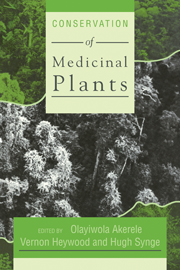Book contents
- Frontmatter
- Contents
- Contributors
- Preface
- Acknowledgements
- The Chiang Mai Declaration
- Introduction
- The Issue of Medicinal Plants
- Science, Industry and Medicinal Plants
- 6 Valuing the Biodiversity of Medicinal Plants
- 7 Economic Aspects of Exploitation of Medicinal Plants
- 8 Industry and the Conservation of Medicinal Plants
- 9 Information Systems and Databases for the Conservation of Medicinal Plants
- Techniques to Conserve Medicinal Plants
- Policies to Conserve Medicinal Plants
- Experiences from Programmes to Conserve Medicinal Plants
8 - Industry and the Conservation of Medicinal Plants
Published online by Cambridge University Press: 07 September 2010
- Frontmatter
- Contents
- Contributors
- Preface
- Acknowledgements
- The Chiang Mai Declaration
- Introduction
- The Issue of Medicinal Plants
- Science, Industry and Medicinal Plants
- 6 Valuing the Biodiversity of Medicinal Plants
- 7 Economic Aspects of Exploitation of Medicinal Plants
- 8 Industry and the Conservation of Medicinal Plants
- 9 Information Systems and Databases for the Conservation of Medicinal Plants
- Techniques to Conserve Medicinal Plants
- Policies to Conserve Medicinal Plants
- Experiences from Programmes to Conserve Medicinal Plants
Summary
Medicinal plants and their parts are a primary source of products for the pharmaceutical industry. Large quantities are used in the preparation of infusions and decoctions both in developing countries, where traditional medicine is still of great therapeutical, social and economic importance, and in the industrialised countries, where an ever-growing proportion of the population is using crude drugs for self-medication. However, an even greater amount of medicinal plants are used by the pharmaceutical industry in the preparation of a wide spectrum of derivatives ranging from traditional extracts through extracts with a high and standardized content of active constituents to chemically pure products, the latter being used directly as medicaments or as starting materials for the manufacture of other, pharmacologically active, substances.
The experience gained over the last few decades in the role of a privileged observer, a role granted to a company producing medicinal plant derivatives, enables us to make some observations:
In the EEC countries all the proprietary medicinal products – prescription drugs and Over-the-counter drugs – must be validated by 1990, whatever the origin of their active constituents, in order to comply with the new EEC rules. Even if some countries, such as France and Germany, will restrict the validation of widely used traditional medicinal plants and extracts to the analytical field, certainly many proprietary medicinal products containing 3, 4 or more drugs or extracts as active constituents will be withdrawn from the market as the scientific and economic efforts to update their chemical and pharmaceutical documentation are not justified by their limited commercial importance and, often, by the lack of a therapeutical rationale. A contraction of the consumption of some medicinal plants is foreseeable, but this is of little importance because the products are already scarcely used.
[…]
- Type
- Chapter
- Information
- Conservation of Medicinal Plants , pp. 141 - 146Publisher: Cambridge University PressPrint publication year: 1991
- 3
- Cited by



